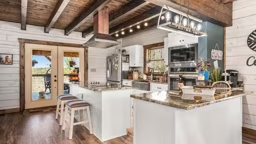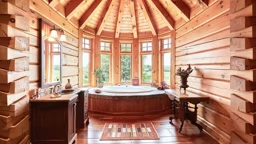
Photo: Roger Wade
In a structure as architecturally interesting as a log or timber frame home, it’s important not to neglect what’s often referred to as the “fifth” wall — the ceiling. After all, what would have happened if Michelangelo left the ceiling of the Sistine Chapel bare?
We’re not suggesting that you need to cover your ceiling in frescoes or murals (though that, too, can make quite a statement — see the section below "What to Do with Drywall”), but there are a variety of shapes, details and applications you can add above that will both impress and inspire.
We’re not suggesting that you need to cover your ceiling in frescoes or murals (though that, too, can make quite a statement — see the section below "What to Do with Drywall”), but there are a variety of shapes, details and applications you can add above that will both impress and inspire.
Read on to learn the ins and outs of six of the most fitting ceiling treatments you’ll find in a log or timber home.
Tray
Used as a flat ceiling treatment, the tray is a two-tiered ceiling where the perimeter is at least 9 feet high with a central inset section raised about a foot higher than the perimeter. It’s an affordable way to give a room a little extra height and architectural interest. Boost the effect with ambient rope lighting, layers of crown molding and barnwood or a contrasting paint color at the deepest part of the tray.
Perfect places to put it:
Bedrooms — particularly the master — benefit from the extra drama a tray ceiling provides.

Photo: Custom Timber Frames
Traditional Vault
In log and timber frame home construction, we frequently talk about vaulted ceilings,but did you know there are a host of varieties within this ceiling genre?Cathedral, ribbed, fanned, domed and barreled (which we’ll discuss in more depth in a minute) — this common ceiling treatment may have its roots in Medieval architecture and Romanesque churches, but it’s right at home in modern log and timber residences. To accentuate the exceptional detail of a vaulted ceiling, stain the trusses a rich dark color against a paler shade of wood.
Perfect places to put it:
No surprise the great room is the most frequent place to show off the vaulted ceiling, but dining rooms, bedrooms and screened-in porches are other areas to consider raising the roof this way.

Home: Honest Abe Log Homes, Photo: Brandon Malone
Barrel Vault
Where a traditional cathedral vault comes to point at its apex, its softer cousin, the barrel vault (also known as a tunnel or wagon vault), consists of a curved, semi-cylindrical arch built under the room’s rafters. Sometimes, multiple concave curves are placed side by side for dramatic effect, but in a log or timber home, it’s most commonto employ a single arch.Perfect places to put it:
This unique ceiling deserves a special spot in the house. Consider a wine cellar, a dramatic master bath or the front entryway roof to greet guests with style.

Custom Timber Log Homes photo by Joseph Hilliard
Coffered
Originating in ancient Greece, the coffered ceiling treatment has found its way into mainstream log and timber homes in a big way. The style features grooved wood or fiberboard panels with molding laid out in a uniform grid to create a three-dimensional overhead experience. The nooks it creates are ideal to soften recessed lighting while emphasizing more spectacular fixtures like chandeliers or pendants.A ceiling height of 9 feet or more is required to keep this striking look from making a room feel cave-like, and expect to pay extra for the expertise it takes
to install it right.
Perfect places to put it:
Kitchens, dining rooms and home offices or libraries all benefit from the warmth and richness coffered ceilings convey.

Home by Kenneth T. Parsons Construction, LLC; Photo by Joseph Hilliard
Beamed
Like vaulted ceilings, log and timber homes are no strangers to exposed beams overhead — especially quaint cabins, post-and-beam chalets and lodge-style houses. Where coffered ceilings are laid out on a grid, beamed ceilings are linear and less intricate. The beams are often structural, but they don’t have to be. In fact, if you love the look but want to save money, you can apply non-structural or even faux beams to emulate the treatment at a reduced cost.
Perfect places to put it:
Beamed ceilings are right at home in every room of a log or timber abode. They are a classic way to accentuate the ceiling in a rustic residence.
Sloped
These are often found in upper-story rooms where the roofline of the house has a steep pitch and the two sides of the ceiling meet at a peak. On the upside, the sloped ceilings create cozy nooks and increase the airiness of rooms. On the downside, the amount of headroom and usable square footage is reduced as the ceiling drops to meet the floor. Recapture those tight spaces by installing built-in dressers or even bunk beds.Perfect places to put it:
A brilliant way to capture some extra living space for secondary bedrooms on the uppermost floor, converted attic-space rooms and lofts, as well as hobby rooms, home theaters and art studios.

Photo: Bill Matthews / Check out that mural on the drywall!
What to Do With Drywall
It’s common to see a timber frame or log home ceiling encased in tongue-and-groove paneling or simply painted white. But what if you’re looking for something uncommon for your own home? Drywall is a blank canvas — bring it to life with one of these four exceptional options.Mural.
Whether it’s a nature scene like the one found in the cozy cabin above or an ornate religious fresco, the bare white walls often found on a log or timber home ceiling deserve a little attention.
Venetian Plaster.
The difference between Venetian plaster and the ordinary variety lies in the limestone and sometimes even marble dust in the mix. It creates a distinctive mottled look that has a lot of movement without bold color. Like its name implies, it does give a space an Italian flair, and it can be a little overwhelming if you’re not careful. For the best results in a log or timber home, stick with soft shades of white, cream or tan.
Ombre Paint.
Since you probably plan to paint your ceiling anyway, why not give it some personality? Ombre is a technique in which the color progressively changes from dark to light in the same color tone — for instance, a gradient from dark midnight blue to medium ocean to pale sky — and is fairly easy and forgiving for a DIYer to tackle.
Tin.
A pressed-tin ceiling is a perfect complement to farmhouse style and a fun alternative to a tongue-and-groove wood treatment. Plus, its reflective properties are a great way to amplify the light in a space.
See also: Decorating With an Antler Chandelier












